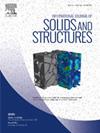一种考虑三维效应的DCB试件剥离试验断裂韧性识别方法
IF 3.4
3区 工程技术
Q1 MECHANICS
International Journal of Solids and Structures
Pub Date : 2025-03-21
DOI:10.1016/j.ijsolstr.2025.113350
引用次数: 0
摘要
通常采用双悬臂梁(DCB)试样,根据ISO或ASTM标准来评估粘合接头和层合复合材料在开放载荷下的断裂韧性。这些标准的公式是基于二维(2D)弹性梁模型的,尽管三维(3D)效应,与DCB试样中裂纹前沿的曲率有关,并影响测量的断裂韧性,存在并在文献中报道。本文提出了一种新的测试方法,通过重新审视最近发表的一种隐式考虑三维效应的退聚模型来评估能量释放率,而不测量裂纹扩展长度。根据杨氏模量计算附着物的弹性行为,只需要载荷和宏观角位移响应。利用有限元软件Ansys APDL对三维DCB试件模型进行了脱粘试验模拟。断裂表面采用内聚元素建模,附着物为各向同性材料。将模拟结果与内聚律计算的断裂韧性进行比较,对采用主动标准和新方法计算的断裂韧性的准确性进行了评价。结果表明,标准化数据约简方案受到高达30%的系统误差的影响,而所提出的方法在断裂韧性评估中的误差与内聚规律相比可以忽略不计。本文章由计算机程序翻译,如有差异,请以英文原文为准。
A fracture toughness identification method for the debonding test of DCB specimens accounting for three-dimensional effects
The fracture toughness of adhesive joints and laminated composites subjected to opening load is commonly evaluated using Double Cantilever Beam (DCB) specimens according to ISO or ASTM standards. The formulations of these standards are based on two-dimensional (2D) elastic beam models, although a three-dimensional (3D) effect, related to the curvature of the crack front in DCB specimens and affecting the measured fracture toughness, is present and reported in literature.
In this paper, a novel test set up is proposed to evaluate the energy release rate by revisiting a recently published decohesion model that implicitly considers the presence of 3D effects, without measuring the crack propagation length. The elastic behaviour of adherends in terms of Young’s modulus and only load and macroscopic angular displacements response are necessary.
Using the finite element code Ansys APDL, several decohesion test simulations of 3D DCB specimen models were performed. The fracture surfaces were modelled using cohesive elements and the adherends as isotropic material. The results obtained from the simulations were used to evaluate the accuracy of the fracture toughness obtained both through the active standards and via the novel approach, by comparison with that imposed in the cohesive law.
The results showed that the standardized data reduction schemes were affected by systematic errors up to 30%, whilst the proposed methodology gave a negligible error in the fracture toughness evaluation compared to that imposed in the cohesive law.
求助全文
通过发布文献求助,成功后即可免费获取论文全文。
去求助
来源期刊
CiteScore
6.70
自引率
8.30%
发文量
405
审稿时长
70 days
期刊介绍:
The International Journal of Solids and Structures has as its objective the publication and dissemination of original research in Mechanics of Solids and Structures as a field of Applied Science and Engineering. It fosters thus the exchange of ideas among workers in different parts of the world and also among workers who emphasize different aspects of the foundations and applications of the field.
Standing as it does at the cross-roads of Materials Science, Life Sciences, Mathematics, Physics and Engineering Design, the Mechanics of Solids and Structures is experiencing considerable growth as a result of recent technological advances. The Journal, by providing an international medium of communication, is encouraging this growth and is encompassing all aspects of the field from the more classical problems of structural analysis to mechanics of solids continually interacting with other media and including fracture, flow, wave propagation, heat transfer, thermal effects in solids, optimum design methods, model analysis, structural topology and numerical techniques. Interest extends to both inorganic and organic solids and structures.

 求助内容:
求助内容: 应助结果提醒方式:
应助结果提醒方式:


